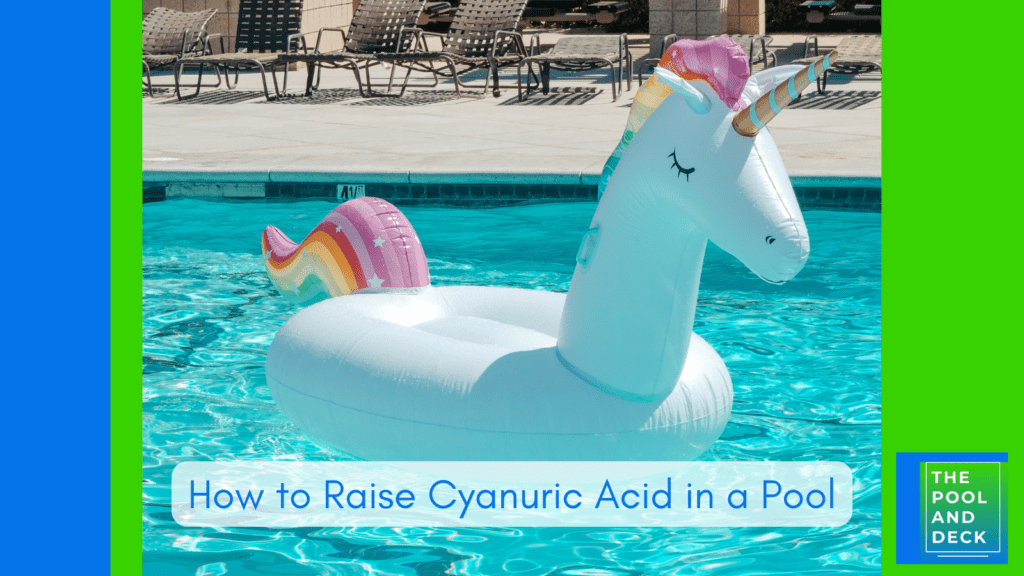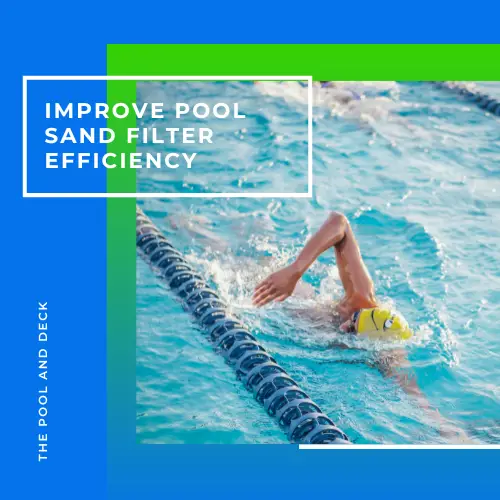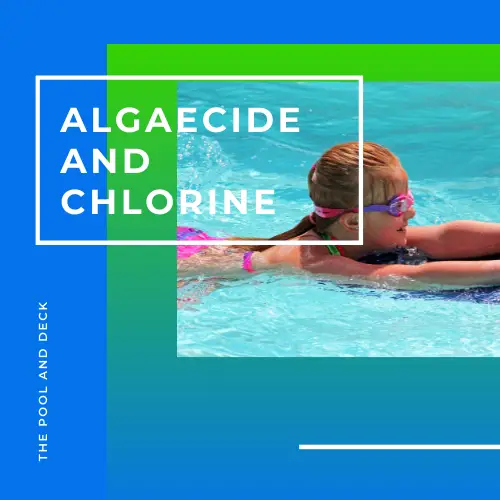The Problem of Low Cyanuric Acid and How to Raise it?
As an Amazon Associate, I earn from qualifying purchases.
Did you know that Free Chlorine (FC) in your pool water gets depleted by 50% every 45 minutes under sunlight, if not protected by Cyanuric Acid?

Low Cyanuric Acid can result in healthy FC levels of 4 ppm to drop to dangerously low levels (less than 1 ppm) in two hours or so!
The photolysis half-life of aqueous chlorine in clear sky, summer noon sunlit (47°N) water of pH 8 is 12 min when measured at the surface. It increases with decreasing pH due to the decreasing ratio of OCl−/HOCl to 60 min at pH 5.
In short, without adequate levels of cyanuric acid (CYA), your pool’s chlorine doesn’t stand a chance against the sun. So, in case of Low Cyanuric Acid, the logical question is how to raise cyanuric acid in a pool?
KEY TAKEAWAYS
- Cyanuric acid (CYA) protects free chlorine from sunlight degradation.
- The ideal CYA level is between 30-50 ppm.
- Low CYA causes rapid chlorine depletion, algae growth, and cloudiness.
- Test CYA levels weekly and use a pool cover to maintain proper levels.
- To raise CYA, use stabilized chlorine or add pure cyanuric acid.
- Trichlor tablets are good for regular chlorine and CYA additions.
- Use Cal Hypo shock as it doesn’t contain CYA.
In this guide, I will show you how to test, adjust, and maintain proper CYA levels—step by step. So, let’s get started.
Table of Contents
What is Cyanuric Acid and Why Is It Important?
The Cyanuric Acid (CYA) molecule comprises 3 atoms each of Carbon, Nitrogen, Oxygen, and Hydrogen. The Nitrogen atoms in CYA can “lock” the hypochlorite ion (OCL-) ions through a weak bond.
As long as the Chlorine atom is attached to the Nitrogen atom, it is not “free”. It is protected from the harsh UV rays of the sun.
Cyanuric Acid: The Sunscreen for Chlorine
Cyanuric acid (CYA) is also known as a pool conditioner or chlorine stabilizer. Its main job is to protect chlorine from the sun’s ultraviolet (UV) rays. Without it, sunlight can break down chlorine in just a few hours, leaving your pool unprotected.
Think of CYA as a sunscreen for free chlorine. It shields chlorine, allowing it to work longer and more effectively to keep your pool clean and safe.
Ideal Cyanuric Acid Levels: The Goldilocks Zone
Like most things in pool maintenance, balance is key. The ideal cyanuric acid levels fall between 30 and 50 parts per million (ppm) for most pools. This range offers just the right amount of protection for chlorine without causing other issues.
Typically, you need 12X – 15X Cyanuric Acid (CYA) to protect Free Chlorine. Please see Table below:
| Free Chlorine (FC) | Cyanuric Acid (CYA) |
| 2 ppm | 30 ppm |
| 3 ppm | 40 ppm |
| 4 ppm | 50 ppm |
- Too little CYA: Chlorine breaks down too quickly and there is not enough to effectively sanitize the pool.
- Too much CYA: Chlorine gets locked in by the CYA and is once again unable to function as an effective sanitizer.
Keeping CYA in the “Goldilocks Zone” ensures that the chlorine can keep your pool sanitized and safe!
Benefits of Maintaining Proper CYA Levels
Why is cyanuric acid so important? Here are the key benefits of maintaining the right levels:
- Prevents chlorine loss from sunlight exposure.
- Reduces the risk of algae growth by keeping chlorine active longer.
- Saves money by cutting down on how much chlorine you need.
- Helps maintain crystal-clear water for a safer, more enjoyable pool experience.
The Perils of Low Cyanuric Acid
You do not want low cyanuric acid levels in your outdoor pool, especially during the bright sunny days of summer.
Telltale Signs of Low CYA
Spotting low cyanuric acid levels isn’t always obvious at first, but there are clear warning signs to look for:
- Chlorine levels fall too quickly after adding it to the pool.
- Algae growth starts showing up, even though you’ve been adding chlorine.
- Your pool water looks cloudy and hard to keep clear.
- You’re spending more money and time adding chlorine, but it’s still not working.
If you notice these issues, there’s a good chance you’re dealing with low cyanuric acid levels in your pool.
Consequences of Neglecting Low CYA
Ignoring low cyanuric acid can create a cycle of frustration and unnecessary costs. Here’s what happens when CYA levels are too low:
- Chlorine Loss: Without CYA to protect it, chlorine breaks down in sunlight and becomes ineffective within hours.
- Algae Blooms: With no chlorine protection, algae can quickly take over your pool.
- Cloudy Water: Unbalanced water and ineffective chlorine lead to poor water clarity.
- Increased Costs: You’ll spend more money on chlorine, trying to fix an ongoing problem.
In short, neglecting cyanuric acid levels means more time, effort, and expenses. Your pool will be harder to manage, and the water may become unsafe for swimming.
Common Culprits Behind Low Cyanuric Acid
Understanding what causes low cyanuric acid can help you prevent it in the future. The most common reasons are:
- Rainwater Dilution: Heavy rainfall or storms can add fresh water to your pool, diluting CYA levels.
- Frequent Backwashing: Backwashing your pool filter removes water, and with it, cyanuric acid.
- Fresh Water Refills: Adding new water to replace evaporation can lower CYA concentration.
- Unstabilized Chlorine Use: Pool chlorine is either stabilized or unstabilized. Stabilized chlorine, such as sodium dichlor and trichlor, already have CYA in them. However, unstabilized chlorine, such as liquid chlorine and cal hypo do not have any CYA.
If you notice your pool stabilizer levels dropping, these culprits are usually to blame. The good news is, you can easily raise cyanuric acid levels once you know the cause.
What is Low Cyanuric Acid?
The acceptable range for Cyanuric Acid for outdoor pools is between 30 and 50 ppm. Low Cyanuric Acid is when the CYA falls below 30 ppm. This can result in a higher depletion rate of chlorine and an increase in unsanitary pool water.
Chlorine is always in the limelight whenever you discuss pool sanitization and the role of pool chemicals in keeping your pool safe for swimming. Almost as important, though less talked about, is Cyanuric Acid (CYA).
CYA levels in your pool must be maintained within the optimal range. This is imperative!
What Happens When Cyanuric Acid Is Too Low?
The result of low cyanuric acid levels in your pool is an unhygienic and unsafe swimming environment. When the cyanuric acid concentration falls below the recommended levels, the pool can be plagued with a myriad of problems.
You may actually notice the effect of a low cyanuric acid level by an increase in the strong chlorine smell.
The smell is from the accumulation of chloramines or combined chlorine in the water. This kind of chlorine is less effective as a sanitizer, making it easier for the pathogens to flourish.
You will also find that as a result of low cyanuric acid levels, there is an increase in chlorine consumption. UV rays in sunlight break down chlorine in pool water quite rapidly.
The result is a substantial depletion in the amount of active chlorine in the pool.
Cyanuric Acid (CYA) reduces the rate of chlorine depletion significantly. Without sufficient CYA in the water, you will find yourself adding more chlorine daily to maintain water cleanliness.
Insufficient active chlorine can lead to the rapid growth of pollutants, bacteria and viruses in the water.
If left unchecked, these microorganisms can cause the water to turn green with algae growth, and some bacteria may even produce black algae or pink slime.
Not only does the inviting crystal clear blue water turn to an unappealing murky green color, it also becomes very dangerous to swimmers and can cause severe health issues.
Furthermore, unbalanced pool water chemistry may occur due to a drop in chlorine levels caused by insufficient CYA levels in the water. This can lead to a chain reaction that affects total alkalinity and pH balance too!
How to Raise Cyanuric Acid in a Pool
Testing Your CYA Levels: Know Before You Act
Before adding anything to your pool, you must test your cyanuric acid levels. Accurate testing will tell you exactly how much you need to adjust.
Here’s how to test your CYA:
- Use a test kit or test strips designed specifically for cyanuric acid levels.
- Follow the instructions carefully—most tests involve mixing pool water with a reagent.
- Compare the results to the recommended range of 30–50 ppm.
If the reading is below 30 ppm, you have low cyanuric acid, and it’s time to raise it.
Recommended Chemical Test Kit
Taylor K-2005 Complete DPD 9-in-1 Test Kit
Tests for free & total chlorine, bromine, pH, total alkalinity, total hardness, and cyanuric acid (CYA) levels.
Method 1: Adding Stabilized Chlorine
Stabilized chlorine is a two-in-one product. It sanitizes your pool while also raising cyanuric acid levels. This is an ideal solution if you already need to add chlorine.
Types of Stabilized Chlorine
- Dichlor: A fast-dissolving chlorine product that contains CYA. Ideal for quick adjustments. Dichlor Shock is a popular product.
- Trichlor: Slower-dissolving chlorine tablets that add CYA over time. Perfect for regular use.
Step-by-Step Guide to Adding Stabilized Chlorine
- Test your current CYA levels to determine how much you need.
- Use the pool size and product instructions to calculate the correct dosage.
- Shock your pool with dichlor for a quick fix while rapidly eliminating build of algae, pathogens, and contaminants.
- Add trichlor tablets directly to the skimmer or in a floating chlorine dispenser for a slow and easy build-up.
- Allow the pump to run for at least 24 hours to circulate the product evenly.
- Retest your CYA levels to ensure they’ve reached the target range.
Using stabilized chlorine is an easy way to tackle both chlorine loss and low cyanuric acid at the same time.
Recommended Di-Chlor Shock
Doheny’s Chlorine Di-Chlor Shock
Calcium-Free Chlorine Shock. Leaves behind no residue/clouds. Great for salt- and liquid-chlorine-based pools
Recommended Trichlor Tablets
HTH 42055 Pool Care 3″ Chlorine Tabs Advanced
Sanitizer, clarifier, and algaecide to protect your swimming pool and swimmers with one easy and convenient tab.
Method 2: Adding Pure Cyanuric Acid (Pool Stabilizer)
If you want to raise cyanuric acid levels without adding extra chlorine, you can use pure cyanuric acid. This product is often labeled as a “pool stabilizer” or “conditioner.”
Types of Cyanuric Acid Products
- Granular Cyanuric Acid: Cost-effective and widely available but requires pre-dissolving.
- Liquid Cyanuric Acid: Quick to use and dissolves instantly, making it ideal for fast adjustments.
Step-by-Step Guide to Adding Cyanuric Acid
- Wear safety gear like gloves and goggles when handling cyanuric acid.
- If using granular CYA, dissolve it in a bucket of warm water before adding it to the pool.
- Slowly pour the mixture into the skimmer while the pump is running.
- Let the pump circulate the water for at least 24 hours.
- Retest the CYA levels to confirm they’re within the 30–50 ppm range.
By following these steps, you can easily raise cyanuric acid levels and prevent further chlorine loss in your pool.
Recommended Chlorine Stabilizer (Cyanuric Acid)
HTH 67061 Pool Care Stabilizer
- EXTENDS CHLORINE LIFE: Helps slow down the degradation of chlorine by direct sunlight
- EASY APPLICATION: Simply add HTH Chlorine Stabilizer directly to your skimmer
Safety Precautions When Handling Cyanuric Acid
- Always add cyanuric acid to water, not the other way around.
- Store CYA products in a cool, dry place, away from children and pets.
- Avoid inhaling dust or fumes, as it can irritate the skin and lungs.
Click on the image below to reach the page with all the Necessary Pool Chemicals.
How to Maintain Cyanuric Acid Within Range
As they say, prevention is better than cure (and cheaper too!)
Regular Testing
Test your cyanuric acid levels weekly in summer and bi-weekly during cooler months. Use reliable test strips or a test kit to keep levels in the ideal range of 30–50 ppm.
Use a Pool Cover
A pool cover minimizes sunlight exposure, reducing chlorine loss and slowing the need to add more cyanuric acid. It also prevents rainwater which dilutes the pool water.
A pool cover will also reduce the risk of algae spores and other airborne contaminants from getting into your pool.
Choose the Right Chemicals
When it comes to using the right chlorine for sanitation I recommend using Trichlor. Trichlor has CYA built in its formulation and is very easy to use. Just put the tablets in the skimmer or floaters and replenish as required.
However, for shocking the pool I recommend using Cal Hypo as it is cost-effective, easy to use, and CYA-free. With Cal Hypo shock you do not run the risk of High Cyanuric Acid levels in your pool, which is tougher to remedy.
Watch Out for High CYA
If cyanuric acid levels rise above 80 ppm, chlorine becomes less effective. Fix this by partially draining and refilling your pool with fresh water.
For more information check out my Pool Chemistry for Beginners: With 5 Super Helpful Cheat Sheets!
Thank you very much for reading the post. I do hope you found it informative and helpful.











